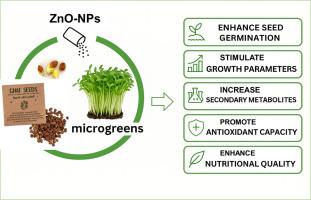Ghaf microgreen: A novel functional food with enhanced nutritional content via nanoparticle-seed priming
IF 8.2
Q1 FOOD SCIENCE & TECHNOLOGY
引用次数: 0
Abstract
Introducing novel microgreens from the UAE-native ghaf plant into culinary traditions enriches dishes with nutrients and addresses sustainability challenges related to nutritional security. Microgreens are renowned for their dense nutrient profile compared with mature plants. This study investigated the potential of leveraging nanotechnology to enhance the resilience and productivity of ghaf microgreens and enhance their economic and nutritional values. Using ZnO![]() NPs at a concentration of 500 ng/mL significantly stimulated the germination of ghaf seed, which peaked after 5 days (93 %) compared with the control (22 %). Analysis of mineral content revealed a considerable increase in the majority of the essential nutrients, particularly Zn, which increased by 9–10-fold in treated seeds and microgreens compared with the control. The treatment of ZnO
NPs at a concentration of 500 ng/mL significantly stimulated the germination of ghaf seed, which peaked after 5 days (93 %) compared with the control (22 %). Analysis of mineral content revealed a considerable increase in the majority of the essential nutrients, particularly Zn, which increased by 9–10-fold in treated seeds and microgreens compared with the control. The treatment of ZnO![]() NPs enhanced phytochemical concentration; the phenolic content increased from 379.70 to 415.22 mgGAE/100 gDW in the treated seed and from 501.43 to 774.81 mgGAE/100 gDW in the produced microgreens, thereby enhancing antioxidant activity. Variations in individual phenolic compounds, such as sinapic, gallic, and benzoic acids as well as rutin hydrate, were observed, with sinapic acid demonstrating the highest content in ghaf seed and microgreen leaves (34 % more than that of the control). Furthermore, ZnO
NPs enhanced phytochemical concentration; the phenolic content increased from 379.70 to 415.22 mgGAE/100 gDW in the treated seed and from 501.43 to 774.81 mgGAE/100 gDW in the produced microgreens, thereby enhancing antioxidant activity. Variations in individual phenolic compounds, such as sinapic, gallic, and benzoic acids as well as rutin hydrate, were observed, with sinapic acid demonstrating the highest content in ghaf seed and microgreen leaves (34 % more than that of the control). Furthermore, ZnO![]() NPs enhanced protein synthesis from 2.21 to 2.83 mg/mL in the ghaf microgreens, rendering it a high-value functional food. This study provides valuable insights into the physiological and nutritional responses of ghaf seed to ZnO
NPs enhanced protein synthesis from 2.21 to 2.83 mg/mL in the ghaf microgreens, rendering it a high-value functional food. This study provides valuable insights into the physiological and nutritional responses of ghaf seed to ZnO![]() NPs treatment, laying the groundwork for NP-based strategies to enhance ghaf crop resilience and nutritional value in arid environments.
NPs treatment, laying the groundwork for NP-based strategies to enhance ghaf crop resilience and nutritional value in arid environments.

加夫微绿:一种新型功能性食品,通过纳米颗粒种子启动增强营养成分
将来自阿联酋本土海夫植物的新型微型蔬菜引入烹饪传统,丰富了菜肴的营养,并解决了与营养安全相关的可持续性挑战。与成熟植物相比,微绿蔬菜以其丰富的营养成分而闻名。这项研究调查了利用纳米技术提高海螺微型蔬菜的恢复力和生产力以及提高其经济和营养价值的潜力。500 ng/mL浓度的ZnONPs显著刺激海参种子萌发,5天后达到萌发高峰(93%),高于对照组(22%)。矿物质含量分析显示,处理过的种子和微蔬菜中大部分必需营养素显著增加,尤其是锌,与对照相比增加了9 - 10倍。ZnONPs处理提高了植物化学物质浓度;处理过的种子中酚类物质含量从379.70增加到415.22 mgGAE/100 gDW,产生的微绿叶中酚类物质含量从501.43增加到774.81 mgGAE/100 gDW,从而增强了抗氧化活性。观察到单个酚类化合物的变化,如辛酸、没食子酸、苯甲酸以及水合芦丁,辛酸在海参种子和微绿叶中的含量最高(比对照高34%)。此外,ZnONPs使海参微蔬菜的蛋白质合成从2.21 mg/mL提高到2.83 mg/mL,是一种高价值的功能食品。该研究为了解海胆种子对ZnONPs处理的生理和营养反应提供了有价值的见解,为基于np的策略提高干旱环境下海胆作物的抗逆性和营养价值奠定了基础。
本文章由计算机程序翻译,如有差异,请以英文原文为准。
求助全文
约1分钟内获得全文
求助全文
来源期刊

Future Foods
Agricultural and Biological Sciences-Food Science
CiteScore
8.60
自引率
0.00%
发文量
97
审稿时长
15 weeks
期刊介绍:
Future Foods is a specialized journal that is dedicated to tackling the challenges posed by climate change and the need for sustainability in the realm of food production. The journal recognizes the imperative to transform current food manufacturing and consumption practices to meet the dietary needs of a burgeoning global population while simultaneously curbing environmental degradation.
The mission of Future Foods is to disseminate research that aligns with the goal of fostering the development of innovative technologies and alternative food sources to establish more sustainable food systems. The journal is committed to publishing high-quality, peer-reviewed articles that contribute to the advancement of sustainable food practices.
Abstracting and indexing:
Scopus
Directory of Open Access Journals (DOAJ)
Emerging Sources Citation Index (ESCI)
SCImago Journal Rank (SJR)
SNIP
 求助内容:
求助内容: 应助结果提醒方式:
应助结果提醒方式:


